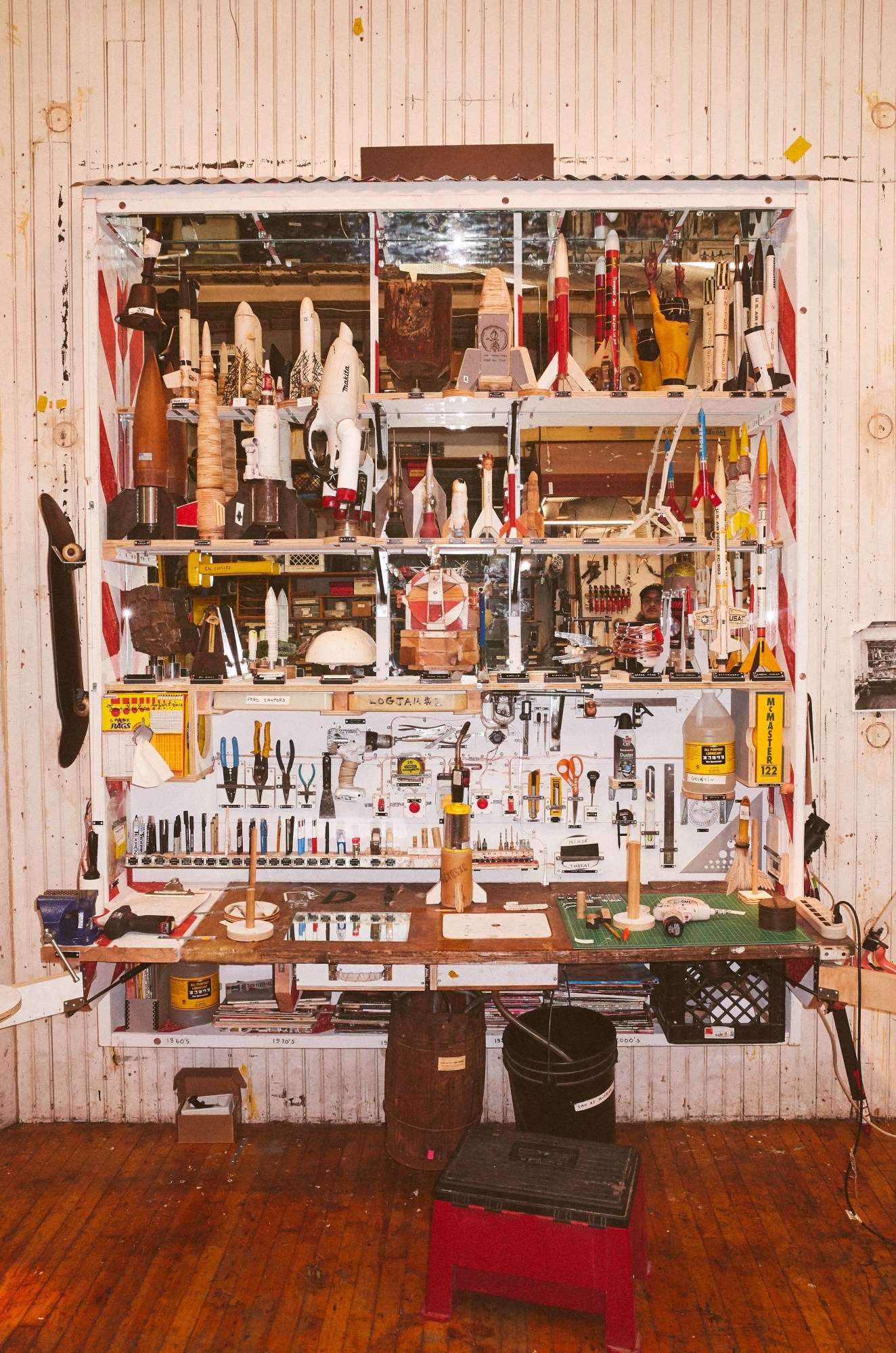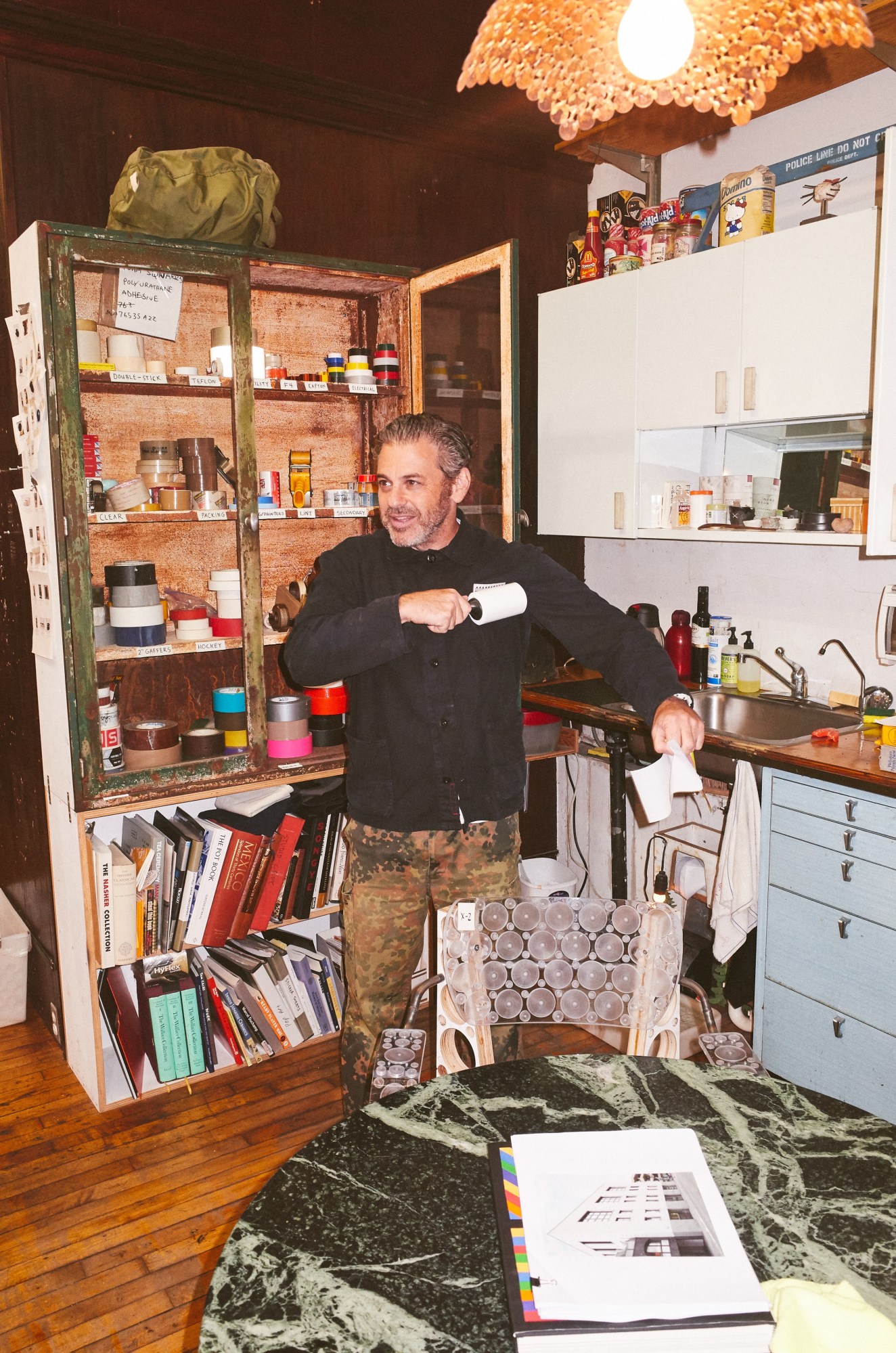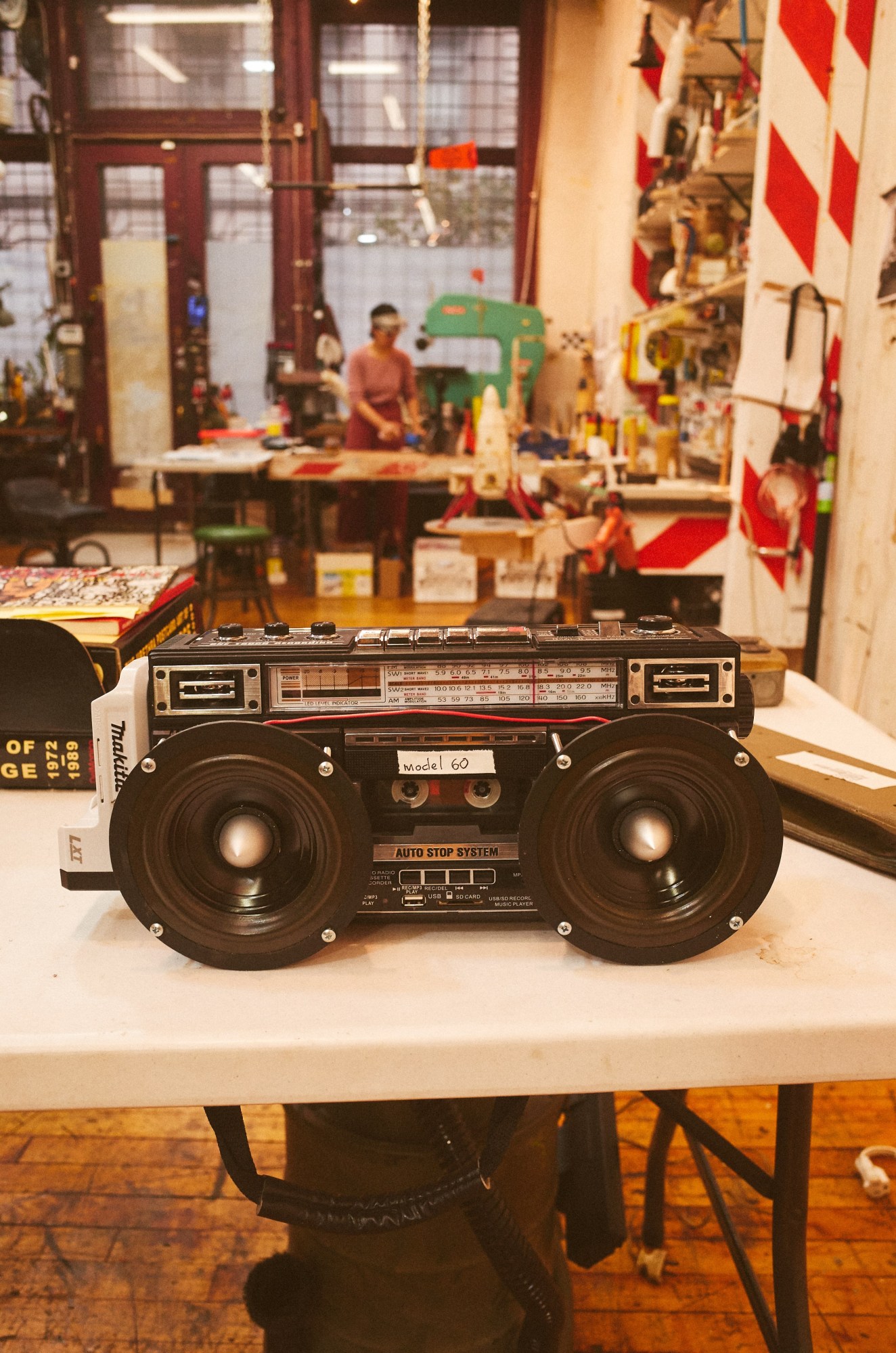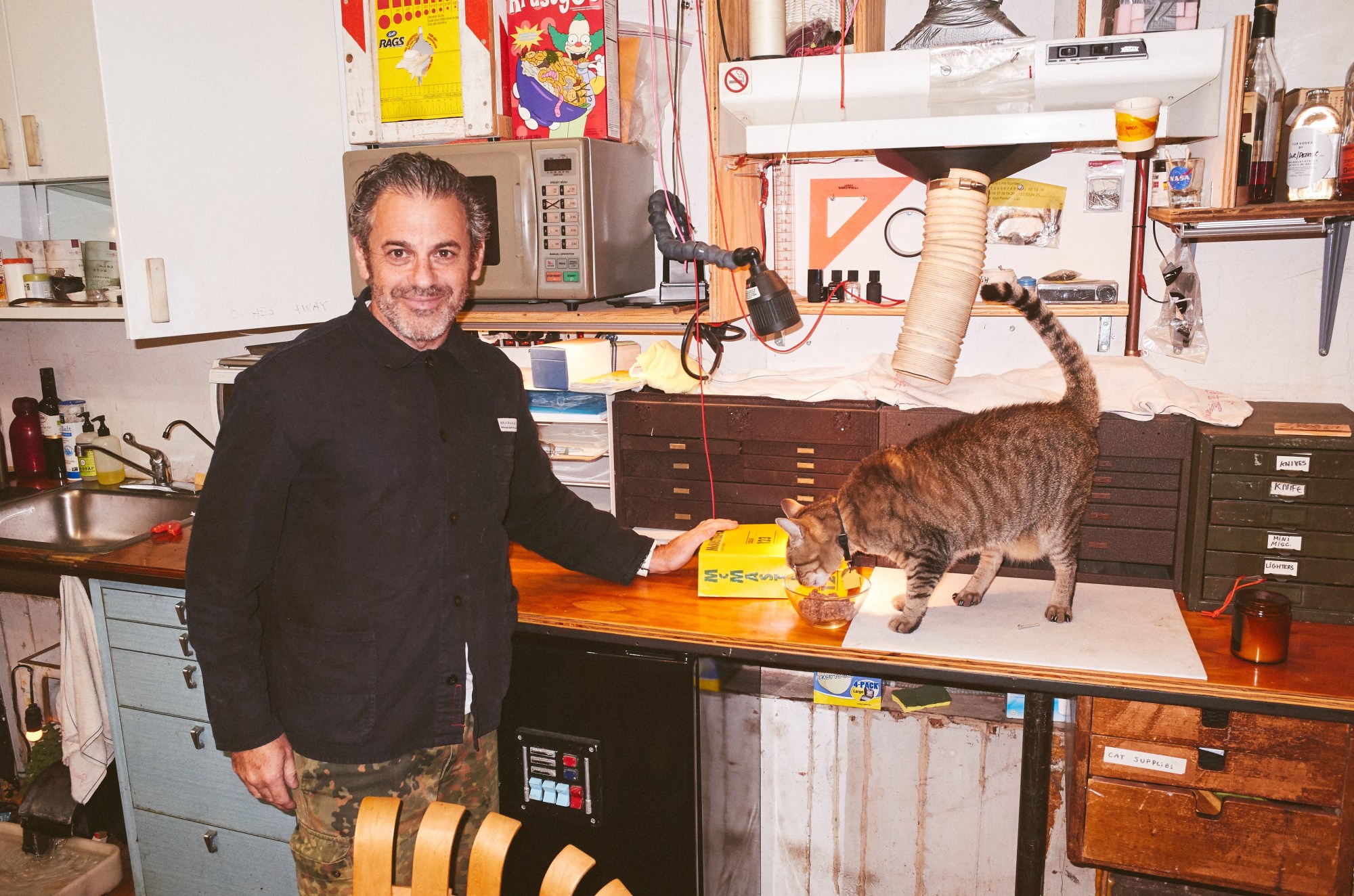Tom Sachs is about to have his first child, a boy he’s considering naming James Brown Sachs. The name is important to the artist because he considers the late music icon to be “one of my people,” meaning someone who Sachs feels indebted to, someone who inspires him to step his game up as a creator. “It’s James Brown who makes me want to make sculptures, not Brâncuși or someone who would make sense,” he tells me in his studio as he preps for this month’s Objects of Devotion exhibition, his fourth solo show at Sperone Westwater Gallery in Soho.
The Centre Street studio is labyrinthine — a sprawling, multi-floor space he built out after moving into the ground floor in 1990. Everything is obsessively organized, from the reservoir of tools and hardware available in all corners, to a section with vintage porn meticulously cataloged. Sachs’ beloved French bulldog Napoleon runs around with a cone on his head, at one point antagonizing Monkey the cat, who darts dangerously close to Hello Kitty Nativity, the 1994 Barneys window installation that famously resulted in Sachs receiving “a series of death threats” and condemnation from The Catholic League. It sits on a ledge overlooking a room where a few new works are being finessed, including the modified boombox that appeared (along with the artist) in the recent Frank Ocean video for “Provider.”
“I think an artist can either have a new idea, or a new way of expressing ideas that are already out there,” the sculpture and bricolage maestro once said. “Only a real genius can do both at the same time, but I’m not that kind of person.” James Brown is that kind of person, for Sachs. The 51-year-old has even dedicated multiple past works to the Godfather of Soul, including a cabinet of curiosities (a.k.a. a wunderkammern) called James Brown’s Hair Products (2009), which was filled with Brown’s curlers, combs, and styling gels bought in a Christie’s auction. And on top of paying homage to the legend through his unborn son, James Brown is honored in a new Sachs sculpture — a cabinet featuring a few dozen jerry-rigged but functional rockets, each named after notable individuals who Sachs considers his people.

For example, Sarah Hoover, his wife and the mother of his child, is represented by a rocket Sachs originally built as a kid in the 70s. It’s been updated for the installation piece and now features a baby foot visible in the space craft’s body. Another rocket is named “King Tubby” and sports 3M-brand tape dispenser detailing, partly because 3M is Sachs’s favorite “blue-chip company” and partly because he feels “tape represents one of the foundational tools for bricolage,” the DIY creation process that deeply informs his practice. Plus, “reggae music — in particular dub music, of whom King Tubby is one of the lead purveyors — is a music that’s taped together. It’s synthesized with different cultures, it’s stripped down and rebuilt and slammed together,” just like his own work.
The aeronautical wunderkammern also shouts out Soviet rocket engineer Sergei Korolev, Fela Kuti, Glenn O’Brien, and Agamemnon — more figures Sachs associates with or wants to pay tribute to. There’s even a rocket made out of a rubber chicken, but Sachs modified it so it can be used as a “chicken fleshlight.” “Each one is a different story and represents a different person,” he says of the idiosyncratic projectiles. “I imagine Carl Sagan, my hero, as a chicken fucker.” He pauses for a moment then adds with a slight smile, “I’m not a chicken fucker.” The rockets can actually fly, too.
There are several other cabinets Sachs built for the exhibition. Many of them feature relics from the various “Space Program” shows that skyrocketed the artist from art world darling to cultural icon. One features rocks that Sachs and his space fleet “harvested from the surface of Mars” during Space Program 2.0: MARS (2012), the four-week blockbuster exhibition at New York’s Park Avenue Armory that involved meticulous, realistic interplanetary exploration demonstrations in front of live audiences. Before he repurposed the Mars rocks for the new wunderkammern sculpture, Sachs sent them to Brooklyn College to have a petrographic analysis done. “They came back and it turned out that yes, in fact, the rocks we jackhammered out of the floor [of The Armory] were concrete. It takes a lot to get that kind of insane, deadpan joke out of it and make it count.”

Ultimately, the works he made for Objects of Devotion all spotlight material things the artist considers to be so significant that they cannot be assigned monetary value (assuming, of course, you can willfully ignore that the art is for sale). “When things get really precious, you don’t even think about the money — like love, new relationships with people, and your time,” he says. “These are objects that are so valuable that even the wealth of a nation couldn’t produce something like a moon rock. People’s desire for them is beyond economics and enters the realm of sexuality.”
Sachs’ own fervor for certain processes, crafts, subjects, and objects is so intense that veneration becomes arousal for him, as well. This is evident in everything from his 2012 video “Love Letter to Plywood” to works in the new exhibition where specific artifacts appear on ornate-but-crude pedestals, suggesting they are worthy of worship. Vaguum, for example, holds individual space rocks in a transparent vacuum chamber that mimics the atmospheric conditions of Mars. It also has a valve to control the suction of a fleshlight attached to the sculpture, “so you have the opportunity to actually make love to your moon rocks.”

Sachs describes this semi-logical conclusion of how one can express devotion to objects with an amused look on his face that stops just short of being devious. There isn’t a wink or an underlying intent to shock anyone. He disregards the idea of making “bad-boy art.” Rather, he is obsessed with the process of both making stuff and consuming stuff — be it weapons with haute couture brand logos on them, or a miniaturized McDonald’s — and approaches it with a particular reverence and irreverence in his craftsmanship, stylization, and prolific output.
One could make the case that his fetishization of items like a McMaster-Carr tool catalog, which cameos at Sperone Westwater in a sculpture called McMasterbation, isn’t all that different from a religious fanatic’s relationship with the Bible. Or that his studio, with its strict and notorious “Ten Bullets” (a Sachsian take on the Ten Commandments), is run like a house of worship. He’s known to say “to work is to pray,” after all. To me, he adds that “it takes a lot to build and maintain a cult,” referring to his tireless studio team and overall practice. “There’s no rest for the wicked. We’re all really devoted to it.”
On top of the solo show in New York, he’s also presenting Tea Ceremony at the Nasher Sculpture Center in Dallas from September 16th through early 2018. The exhibition, which was first organized by the Noguchi Museum in 2016, involves Sachs’ eccentric take on chanoyu — the traditional Japanese tea ceremony — and will include demonstrations of the practice, as well as screenings of a new film also called Tea Ceremony. The Nasher asked Sachs to curate a selection of works from the museum’s permanent collection, and he picked modernist sculptures by seminal artists like Giacometti, David Smith, Barnett Newman, and Brâncuși.
I ask if he sees himself in the lineage of the these canonical figures. “These are the people that inspire me,” he explained earnestly, underscoring that he’s as devoted to his people as he is to his rituals, tools, and moon rocks. “That’s more important than whether or not I see myself in history. That’s for you and the others to decide. For me, I just have to decide what turns me on.”
‘Objects of Devotion’ is on view at Sperone Westwater in New York from September 5, 2017-October 28, 2017.
‘Tom Sachs: Tea Ceremony’ is on view at The Nasher Sculpture Center in Dallas, Texas, from September 16, 2017-January 7, 2018.

